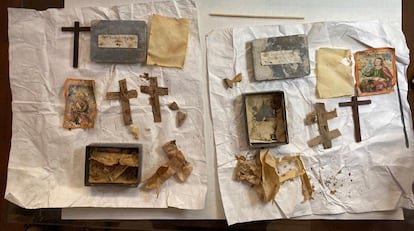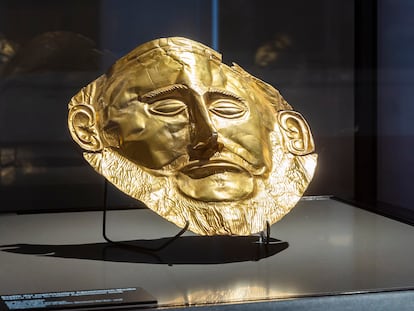Restoration of Mexico City Cathedral reveals time capsules hidden during construction
The discovery of 23 lead boxes containing relics and images of saints was made in December. Authorities say they will be returned to their original position

One day in late December, shortly after 10am, a clay tile from the main dome of the Mexico City Metropolitan Cathedral came loose, revealing the first find: a lead box bearing an inscription in Latin that was small enough to fit in the palm of the restorer’s hand. Inside was a color painting on parchment, depicting a passage from the Bible. Workers continued to remove tiles for eight hours, revealing another 22 opaque metal boxes, worn by age and with white stains similar to the first one. The discovery occurred during the restoration of the cathedral, which suffered “moderate” damage during the 2017 earthquake and now requires constant renovation work. When all the boxes had been revealed, the workers knew they had valuable objects on their hands.
Arturo Balandros, director of the Mexican Secretariat of Culture’s Sites and Monuments of Cultural Heritage department, announced the discoveries last Friday. “It is very exciting,” he said. Balandros said this type of discovery occurs “commonly” when monuments with such a long history are being worked on. Since the 2017 earthquake, 1,579 temples and places of worship have been restored, according to Balandros. “In the hypothesis of researchers and cathedral theologians, these boxes contain images of the protector saints who spread a mantle over the cathedral complex of our city,” he added.

The boxes appeared in small rectangular, shallow niches found in the cathedral’s lantern: the tubular space that tops the central dome of the building and allows light and air to enter. Maricarmen Castro, restoration coordinator of the National Institute of Anthropology and History, tells EL PAÍS that for 10 days her department worked “at full speed” to analyze the objects. “It was a unique opportunity,” adds the restorer. Although the experts cannot determine with certainty who placed the boxes there and when, they estimate that it could have been in the 17th or 18th century, in a ritual to offer protection to the building. When the boxes were removed from the niches to be examined, Castro ordered a cross and a religious image to be inserted in place of each one, to “continue with the protection.”
Some of the 23 boxes bear Latin inscriptions alluding to saints or divine beings. For example, one of them carries a prayer to Jesus of Nazareth asking for protection and mercy. Others, by contrast, bear no clue or reference as to what is contained inside. Upon opening them, the experts found paintings, crosses made of wood or palm, or fragments that “probably” constituted clay or wax medallions. Some were in a good state of preservation but others, as can be seen in images published by the Secretariat of Culture, have been damaged by humidity or are incomplete or broken. One of the boxes had been ransacked and emptied.

Balandros says these discoveries reflect the “final period of the cathedral’s construction.” The Mexico City Metropolitan Cathedral, which is located in the capital’s main square, the Zócalo, was built over the course of 240 years, between 1573 and 1813. The architect who started the project was Claudio de Arciniega, who based his design on the New Cathedral of Salamanca in Spain. By the time the cathedral was completed, the architect in charge of the works was Manuel Tolsá, who finished the façade, the towers and the dome. One of the painters who was working on the Cathedral at that time, and who was possibly part of Tolsá's team, found one of the boxes, which was dedicated to Saint John the Baptist.
The researchers who uncovered the boxes last December were able to verify this because one of them contained a piece of paper dated 1810 and bearing the following inscription: “Severo Arceo and Nicolás Serrano, painters, and José Félix, José Sicilio and Juan García, masons, and Juan Flores, carpenter, when this dome was painted in 1810, found these relics of his holiness John the Baptist. Pray to God for their souls. The Archbishop Don Francisco Xavier de Lizana y Beaumont was viceroy, Fernando VII ruled in Spain and Napoleon Bonaparte in France.” The restorers believe that this box “was the only one found and opened that year.”
When the analysis of experts from the National Institute of Anthropology and History is completed, the authorities have said the boxes will be returned “to their original position” in the lantern of the central dome. They will be reinforced with protective packaging to aid their conservation. Restoration work on the cathedral, which began in 2019, is nearing completion. During these efforts, attention has been given to the pillars that maintain the stability of the building, which was constructed on soft ground that has caused constant sinking. Flora growing in the stone joints has been removed and the electrical system and lightning rod have also been renovated.
Sign up for our weekly newsletter to get more English-language news coverage from EL PAÍS USA Edition
Tu suscripción se está usando en otro dispositivo
¿Quieres añadir otro usuario a tu suscripción?
Si continúas leyendo en este dispositivo, no se podrá leer en el otro.
FlechaTu suscripción se está usando en otro dispositivo y solo puedes acceder a EL PAÍS desde un dispositivo a la vez.
Si quieres compartir tu cuenta, cambia tu suscripción a la modalidad Premium, así podrás añadir otro usuario. Cada uno accederá con su propia cuenta de email, lo que os permitirá personalizar vuestra experiencia en EL PAÍS.
¿Tienes una suscripción de empresa? Accede aquí para contratar más cuentas.
En el caso de no saber quién está usando tu cuenta, te recomendamos cambiar tu contraseña aquí.
Si decides continuar compartiendo tu cuenta, este mensaje se mostrará en tu dispositivo y en el de la otra persona que está usando tu cuenta de forma indefinida, afectando a tu experiencia de lectura. Puedes consultar aquí los términos y condiciones de la suscripción digital.
More information
Archived In
Últimas noticias
Trump followed CIA recommendation to hand power to Delcy Rodríguez due to risk that Machado would not control the army
The Motherwell painting that Franco wanted to hide from view
Mexico seeks to shore up its defenses following US incursion in Venezuela
Hope gives way to uncertainty among Venezuelan exiles in the US after Maduro’s capture
Most viewed
- Alain Aspect, Nobel laureate in physics: ‘Einstein was so smart that he would have had to recognize quantum entanglement’
- Alvin Hellerstein, a 92-year-old judge appointed by Bill Clinton, to preside over Maduro’s trial in New York
- Cuba confirms death of 32 of its citizens in the US attack against Venezuela
- Gilles Lipovetsky: ‘If you want to live better and fall in love, take Prozac, don’t look to philosophy’
- Why oil has been at the center of Venezuela-US conflicts for decades










































